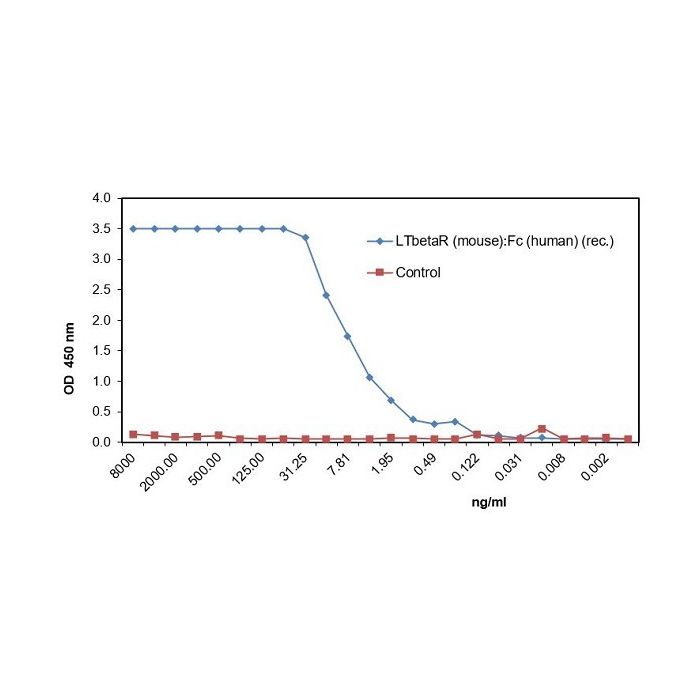Cookie Policy: This site uses cookies to improve your experience. You can find out more about our use of cookies in our Privacy Policy. By continuing to browse this site you agree to our use of cookies.
AdipoGen Life Sciences
LIGHT, Soluble (human) (rec.)
As low as
145
CHF
CHF 145.00
In stock
Only %1 left
AG-40B-0009-C01010 µgCHF 145.00
AG-40B-0009-30103 x 10 µgCHF 290.00

Figure 1: LIGHT, Soluble (human) (rec.) (Prod. No. AG-40B-0009) binds to its receptor mouse LTβR. Method: LTβR (mouse):Fc (human) (rec.) (Prod. No. AG-40B-0274) is coated on an ELISA plate at 2µg/ml overnight at room temperature. LIGHT, Soluble (human) (rec.) (AG-40B-0009) or a control Omentin (human) (rec.) (Prod. No. AG-40B-0042) are added (starting at 8000 ng/ml with a twofold serial dilution) for one hour and then detected using an anti-FLAG-HRP antibody.
| Product Details | |
|---|---|
| Synonyms | HVEML; Tumor Necrosis Factor Ligand Superfamily Member 14; TNFSF14; CD258 |
| Product Type | Protein |
| Properties | |
| Source/Host | CHO cells |
| Sequence | Human LIGHT (aa 89-240) is fused at the N-terminus to a FLAG®-tag. |
| Crossreactivity |
Human Mouse |
| Specificity | Binds to human and mouse LTβR and human HVEM and DcR3. |
| MW | ~25kDa (SDS-PAGE) |
| Purity | ≥95% (SDS-PAGE) |
| Endotoxin Content | <0.01EU/μg purified protein (LAL test; Lonza). |
| Concentration | 0.1mg/ml after reconstitution. |
| Reconstitution | Reconstitute with 100μl sterile water. |
| Formulation | Lyophilized. Contains PBS. |
| Other Product Data |
UniProt link O43557: LIGHT (human)AfCS Signalling Gateway link A001406: LIGHT (mouse) FLAG is a registered trademark of Sigma-Aldrich Co. |
| Shipping and Handling | |
| Shipping | BLUE ICE |
| Short Term Storage | +4°C |
| Long Term Storage | -20°C |
| Handling Advice |
After reconstitution, prepare aliquots and store at -20°C. Avoid freeze/thaw cycles. Centrifuge lyophilized vial before opening and reconstitution. PBS containing at least 0.1% BSA should be used for further dilutions. |
| Use/Stability |
Stable for at least 6 months after receipt when stored at -20°C. Working aliquots are stable for up to 3 months when stored at -20°C. |
| Documents | |
| MSDS |
 Download PDF Download PDF |
| Product Specification Sheet | |
| Datasheet |
 Download PDF Download PDF |
Description
LIGHT (HVEML; CD258) is a cytokine that binds to TNFRSF3/LTBR. It activates NF-κB, stimulates the proliferation of T cells, and inhibits growth of the adenocarcinoma HT-29. Acts as a receptor for Herpes simplex virus.
Product References
- Tumor necrosis factor receptor family costimulation increases regulatory T-cell activation and function via NF-κB: M. Lubrano di Ricco, et al.; Eur. J. Immunol. 50, 972 (2020)





